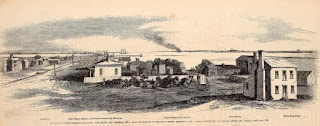Battle of Plymouth Anniversary: THREAD FOUR
How Did the Confederates Capture Plymouth, North Carolina in April 1864?
But everything changed when the ironclad Albemarle arrived early on April 19th and attacked the USS Southfield and Miami, ramming & sinking the former immediately and driving the Miami away downstream.
The Albemarle’s victory made all the difference. The Union positions at Plymouth were not designed to protect from a naval threat. With the rebel gunboat firmly in control of the Roanoke River, it shelled the rear of Union positions. And Hoke prepared to land a decisive blow.
On April 20, Matt Ransom’s brigade, supported by the Albemarle, attacked the Union left to the east of Plymouth, overran the detached positions there, and flooded into town behind the Federal lines. After intense fighting, Union commander Henry Wessells surrendered to Hoke.





























